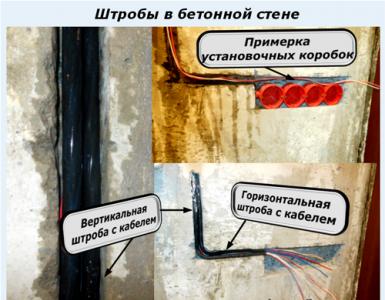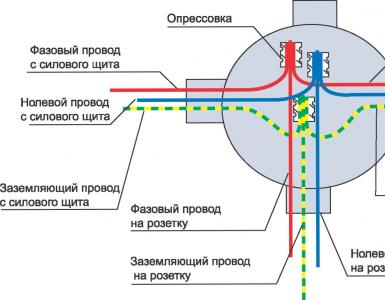How to make drainage at a summer cottage with your own hands - a step-by-step guide to drainage with photos and videos
The problem of flooding and increased waterlogging of the soil is familiar to the owners of plots located in the central region of Russia. Dampness and stagnation of water after melting snow does not allow for proper preparation of the summer cottage for the summer season, and waterlogging of the soil with constant precipitation is detrimental to many plants. There are several ways to solve these problems, but the most effective is the arrangement of drainage.
When is a drainage system necessary?
Drainage is a technology for collecting and draining ground, melt and storm water from a site, technical and residential buildings. The drainage system prevents leaching, swelling and waterlogging of the soil, which occurs due to oversaturation of moisture.
Arrangement of a drainage system is not necessary in every area. In order to determine how much your site needs drainage, you will need to conduct a visual inspection. Pay attention to whether the area is heated after the snow melts, how quickly the water is absorbed after watering the plants, whether there are puddles after heavy rain and downpour. If you have observed these signs more than once, then drainage is required.
The drainage system helps to remove stagnant water from the site
If there is little visual confirmation, then a simple experiment can be carried out - using a hand drill or an ordinary shovel, you should dig a hole 70–100 cm deep. It is better to do this in several places on the site. If, after 24–36 hours, water accumulates at the bottom of the pit and does not leave, then this is a direct evidence of soil oversaturation with moisture.
Soil drainage is carried out under the following conditions:
- high groundwater table;
- the site is located in an area with clay soil;
- the site is located in a lowland or vice versa - on a slope;
- a large amount of precipitation falls at the site of the site.
The presence of drainage contributes to the preservation of finishing and facing materials used for laying garden paths, finishing the basement and facade of the building.
Types of drainage systems
There are a great variety of land drainage systems. Moreover, in different sources, their classification can be very different from each other. In the case of drainage systems for suburban and suburban areas, it is recommended to use the simplest and most proven solutions.
Surface drainage
Surface drainage is the simplest and most effective system. The main task is to drain the soil by draining water generated as a result of heavy rainfall and uneven melting of snow.
The grates protect the open drainage system from the ingress of large debris
A surface drainage system is constructed over the area of the site, around the house and adjacent buildings, near garage structures, warehouses and a courtyard. Surface drainage is divided into two subspecies:
- Point - in some sources it is referred to as local drainage. It is used to collect and drain water from a specific place on the site. The main area of application is dehumidification of areas under gutters, near entrance doors and gates, in the area of the location of containers and taps for irrigation. It is often used as an emergency system if another type of drainage is overloaded.
- Linear - used to drain the entire site. It is a system consisting of receiving trays and channels arranged at a certain angle, providing a constant flow of water. The drainage system is equipped with filter grates and sand traps. Trays and drains are made of PVC, polypropylene, HDPE or polymer concrete.
When installing a surface drainage system, it is recommended to combine point and linear drainage. This will ensure the most efficient operation of the system. If necessary, point and line drainage can be combined with the system described below.
Deep drainage
Deep drainage is carried out in the form of a pipeline laid in places where it is necessary to constantly drain the soil or lower the groundwater level. Drains are laid in compliance with the slope in the direction of the flow of water, which enters the collector, well or reservoir located outside the site.
The process of constructing deep drainage in a suburban area
To lower the groundwater level, pipes are laid along the perimeter of the site to a depth of 80–150 cm. In the case when it is necessary to drain water from the foundation of the structure, the pipes must be laid below the depth of its occurrence. And also drainage pipes can be laid over the entire area of the site with a certain step. The distance between drains depends on their depth and the texture of the soil.
For example, when installing a drainage system, when drains are laid to a depth of 0.9–1 m, the recommended distance between them is at least 9–11 m. On loamy soil, under the same conditions, the step between drains decreases to 7–9 m, and on clayey up to 4–5.5 m. More detailed data for different depths can be seen in the table below. Information taken from the book "Drainage of Land for Gardens" by A.M. Dumblyauskas.
| Drainage depth, m | Distance between drains, m | ||
| Sandy soil | Loamy soil | Clay soil | |
| 0,45 | 4,5–5,5 | 4–5 | 2–3 |
| 0,6 | 6,5–7,5 | 5–6,5 | 3–4 |
| 0,9 | 9–11 | 7–9 | 4–5,5 |
| 1,2 | 12–15 | 10–12 | 4,5–7 |
| 1,5 | 15,5–18 | 12–15 | 6,5–9 |
| 1,8 | 18–22 | 15–18 | 7–11 |
When laying the pipe, the features of the terrain are observed. According to the technology, drains are laid from the highest to the lowest point on the site. If the site is relatively flat, then a slope is formed along the bottom of the trench to give a slope. The minimum slope level is 2 cm per 1 lm of the drainage pipe when constructing drainage in clay and loamy soil. For sandy soil, a slope of 3 cm per 1 m is observed.
When installing a long drainage system, a minimum slope should be observed along the entire length of the drainage line. For example, for a drainage system with a length of 15 m, the minimum level difference between the starting and ending points of the route will be at least 30 cm.
If possible, it is recommended to exceed the declared slope norms. This will provide faster drainage, reduce the risk of siltation and clogging of the drain. In addition, digging a trench with a steep slope is much easier than measuring 1–2 cm.
Drainage at their summer cottage - the easiest ways with instructions
In order to independently carry out the drainage of a land plot through a drainage system, you will need to familiarize yourself with the technology of work, calculate and purchase the necessary materials, prepare a tool and a place for performing work.
Surface drainage of the suburban area
Open surface drainage is a versatile solution for draining small suburban areas. For example, for typical plots with an area of 6 acres. You can take the diagram below as a basis. It depicts a herringbone-shaped drainage line. The distance between the drains, as discussed above, is selected based on the type of soil (see table).
An example of the location of the drainage system at a summer cottage
To carry out the work, you will need a shovel and bayonet shovel, a tape measure, a bubble level, a hammer and a sharp construction knife. As materials, you will need to prepare gravel of fraction 20-40, geotextile, edged bar or board 2-3 m long.
For the construction of surface drainage at the summer cottage, you will need to do the following:
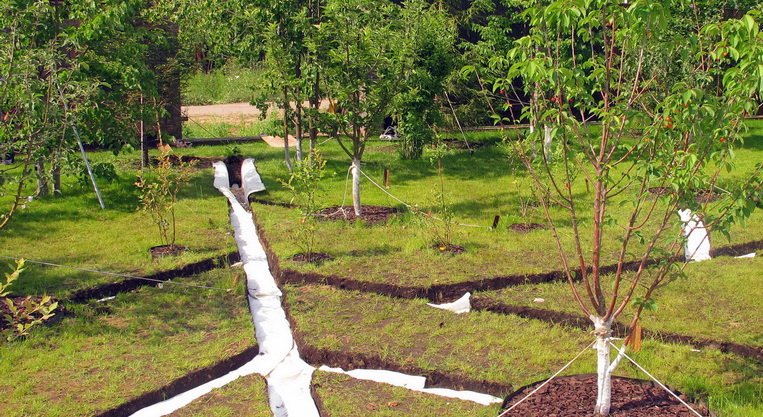
Sometimes, the base of the trench is concreted along the entire length of the drainage line. This allows you not to worry that over time the earthen walls will begin to crumble, water flow will worsen, etc. But this approach is more time consuming and requires the ability to work with a concrete mixture.
Drainage of the site using deep drainage
Deep drainage is a standard solution for draining summer cottages and suburban areas. The deep drainage system can be installed even when there is a protective blind area, concrete or slab paths around the building. If necessary, they can be partially dismantled, but in general, the structure will not suffer.
An example of a drainage system project in a suburban area
Deep drainage works include the following:
- According to the project plan of the site, it is necessary to draw up a diagram of the location of drainage pipes and determine the point of water discharge, that is, the place from where the collected water will be discharged into the sewer pipes leading to the drainage well. The depth of the pipeline must be below the level of soil freezing. For the Northwest region, this value is about 60–80 cm.
Preparation of trenches for the construction of deep drainage
- Taking into account the plan, a trench is being dug along the perimeter and area of the site up to 1 m deep. The trench width is at least 30 cm. All horizontal trench sections are combined into a single system, which is brought to the point of water discharge. After that, trenches are dug with a slope of 2–4 cm per 1 m of the surface. To check the quality of the runoff, trenches are spilled with a large volume of water. If necessary, the slope increases towards the drainage well.
A pit for a drainage well must be dug at the lowest point on the site
- At the lowest point of the site, a place is arranged for the installation of a water intake or filter drainage well. For large areas located on loamy and clayey soil types, it is better to install storage types of wells with a volume of up to 1000 liters. For small areas, both storage and filtering wells can be used. The type of tank is selected based on the type of soil.
A wide sheet of geotextile is laid on top of the gravel layer
- Fine gravel is poured into the bottom of the trench. Layer thickness - 10 cm. Geotextile is laid on the gravel with an overlap on the walls of the trench. To fix the canvas to the walls, wooden or plastic pegs are used, which are driven into the ground. After that, a 10 cm layer of crushed stone with a fraction of 50-60 is poured onto the laid geotextile and carefully leveled with respect to the slope. A drainage pipe from Ø 110 mm is laid on the crushed stone.
- Modular inspection chambers are installed at the drain turning points. The diameter and height of the well depend on the expected volume of waste water. To connect the pipe to the mounting hole, a coupling is used, which is coated with a waterproof sealant before joining. Similar actions are carried out to connect the drainage pipe to the well pipe.
An inspection drainage well is installed in places where the drainage pipe turns
- Before backfilling, the drainage system is checked for operability. For this, a large volume of water is discharged along the drains. If the water drains quickly and enters the well, then everything has been done correctly and you can proceed to the final stage. In other cases, you need to look for and fix the problem.
- A 20–30 cm layer of gravel fraction 20–40 is poured over the drainage pipes and carefully leveled. After that, drains with laid gravel are covered with geotextiles. A 10-15 cm layer of quarry sand is poured over the geotextile and carefully compacted. The remaining space in the trench can be covered with fertile soil or ordinary soil from the site.
Ways to drain the site without drainage
Excessive moisture in the soil and stagnation of water at the site are not always associated with a high level of groundwater. Sometimes this is due to abnormally low temperatures and heavy rainfall. The combination of these factors leads to the fact that moisture does not have time to evaporate, puddles and mold are formed on the soil surface.
If, due to some circumstances, the device of a drainage system is impossible, then there are several effective ways to drain the land:
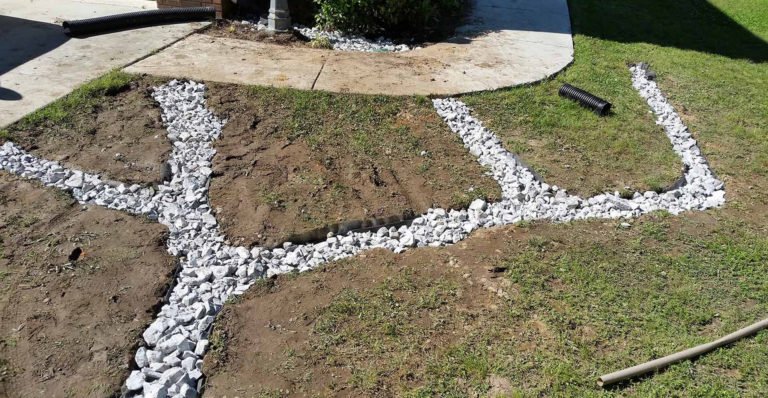
Of the above methods for draining the site, the most effective are the addition of a sufficient amount of fertile soil and the arrangement of trenches around the perimeter. On average, 1 m 3 of soil will cost 550-600 rubles. 10-12 m 3 of soil is enough for a plot of 6 acres.
The easiest way to drain the soil on the site
Arrangement of shallow trenches filled with rubble is the easiest way to drain a summer cottage. Despite its general simplicity, this method is very effective and is able to cope with the large amount of water formed during the melting of snow.
Trenching works around the perimeter and area of the site include the following:
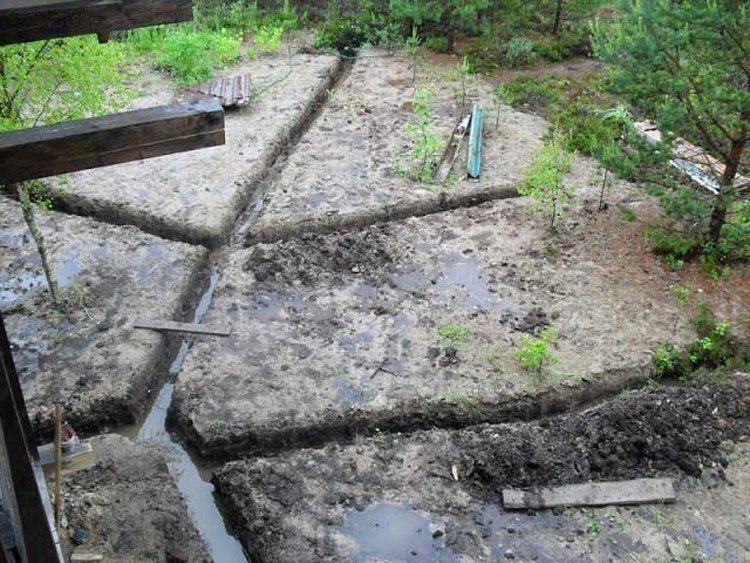
If desired, the second layer of rubble can be reduced, and the remaining space can be sprinkled with soil from the site. This will hide the drainage under the sod layer. It is not recommended to plant flowers and greenery over the drainage trench. This is fraught with their death due to the high humidity in this place.
How to clear a blockage in a drain pipe
Failure to comply with the technology of laying drainage pipes is the main reason for stagnation and poor drainage of water from distribution wells. In addition, very often stagnation of water is not associated with clogging at all. An insufficient slope does not ensure a constant and even discharge of the accumulated water towards the drainage pit.
To clear small blockages, use a steel cable or hose with a strong pressure of water
The easiest way to clean drain pipes is to use a steel cable to clean the drain. At one end of the cable there is a spiral nozzle, at the other there is a handle with which you can rotate the cable, creating a mechanical load in the place of blockage.
For cleaning pipes Ø110 mm or more, it is recommended to use a wire rope with a steel brush of the appropriate size. During the cleaning process, lower the cable into the drainage pipe until its end reaches the blockage. Further, by rotating the cable clockwise, you need to try to break through the blockage or move it towards the water drain. Usually, small accumulations of silt and foliage are pushed through without much difficulty.
If it was not possible to eliminate the blockage, then you will need to call specialists who, using a pneumatic installation and other equipment, will not only clear the blockage, but also carry out preventive cleaning of the entire surface of the drainage pipes.
Video: do-it-yourself drainage of the site
Over-saturation of the soil with moisture and stagnation of water on the site are a big problem that affects not only the growth of fruiting crops, but also reduces the service life of a residential building. But it is worth remembering that an excess of water can be dealt with with the help of a drainage system. It is much worse if there is enough fresh water and moisture, and the arrangement of the well is impossible due to some circumstances.


